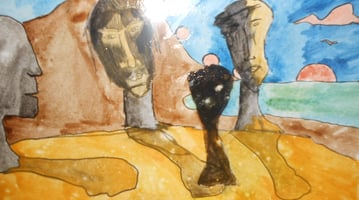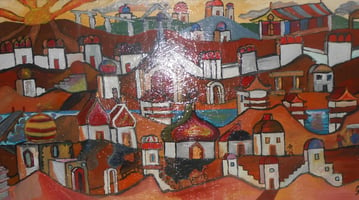



The paintings (pictures) that I present on this site and that can be viewed, painted by me from two thousand and one (when I resumed activity) to the present day, are all inspired by abstract symbolism, expressionism and surrealism. The basic idea behind them is that, although the concept of abstract art can still be accepted and developed as allows new technical frontiers to be explored, it was possible to combine it with a symbolic representation, i.e. of subjects endowed with a still recognisable meaning and which were the means through which abstract configurations could be represented and expressed. Symbolism in painting is nothing other than to make the meaning of the work emerge in a more pronounced manner than in other schools (such as Impressionism) where it is only hinted at. As if the pictorial work contained not only the subject or idea itself, but also its own explanation (or manifest meaning) . What a work of art can signify concerns hermeneutics rather than aesthetics in the strict sense: provided that a figurative work therefore can or must signify something rather than nothing; it somehow conveys a semblance of a concept or an idea that transpires from the mere painted subject, from what is painted and from the manner in which it is painted. What the painting contains is its apparent form (eidolos); what it signifies is its essence (ousia) or meaning. Hence the effort to ‘understand’ a work is nothing more than bringing out that essence from the innermost folds of appearance.
Much has been written and said about painting technique. I personally have used Gino Piva's manuals (‘La tecnica della pittura a olio’ and ‘Treatise on the Pictorial Art’ now only available online) and Giorgio De Chirico's treatise on the art of painting in order to gain an overview of the techniques involved in oil painting, but they obviously only refer to the more strictly ‘oil painting’ aspect of the painter's work, i.e. the choice of materials and their use; they are therefore not manuals that teach how to paint in the strict sense of the term, but rather, rather they provide the minimum prerequisites to be able to do so. They are therefore not manuals on artistic drawing and painting technique manuals such as landscape painting or portraiture, or on how to paint chiaroscuro, shadows or facial and hand features; such manuals are few in number and available almost only in English, and in any case they constitute only an aid or complement to what is the real tool for learning, i.e. practice or continuous exercise, both in the studio and in the open air. Having said this, a few words on the different techniques: the oldest technique, going back more than a thousand years, is that of tempera mixed with rubber or other painting aids used from time to time. Oil painting, which developed in the sixteenth century with Caravaggio, is undoubtedly the one that in my opinion gives the best results as oil paints make a very wide colour range possible, but it is also the most difficult to learn and master. Painting with acrylic (or vinyl, and therefore synthetic) paints which has been developed recently is perhaps the most popular one, both because of the lower cost of materials and colours and the greater ease of use. Regarding the ‘performance’ of acrylic paints, it is difficult to make an objective judgement. As in all things concerning art, there are its supporters and detractors. I believe that oil painting is more fascinating and that the advent of digital painting makes the advent of digital painting means that it can be considered a direct rival and competitor to acrylic painting. This is starting from the pictorial results, i.e. comparing acrylic painting on canvas with digital painting on screen, which shows the strong similarities between the two. And this is no coincidence, as the colours used by various digital painting software and composed of pixels are commonly referred to as ‘digital paint’. Watercolour painting, especially when combined with Indian ink, makes it possible to create marvellous works, especially on landscape paper, as well as charcoals, which are very suitable for portraiture. The Oriental painting of famous artists such as Hokusai, Hiroshige and many others seems to be based on the latter two techniques (watercolour and ink) but using denser colours and varnishes, perhaps partially diluted, more similar to traditional oil and tempera paints.
The process of painting with oil colours takes place in different phases: imprimatura, or the preparation of the canvas with chalk, glue or other suitable material to make its surface more porous and rough or, on the contrary, smoother and more polished; relief or texturing, or the use of acrylic chalk to paint reliefs or extrusions on the canvas to be painted with oil colours to create an effect of depth; the sketch or outline, with pencil or charcoal, of the drawing to be executed. The actual painting, then, by means of oil paints and auxiliaries or painting mediums such as linseed oil or walnut oil that are applied with brushes and palettes that can be round or flat; usually then a second painting phase to define the details; and then the drying of the finished painting that can last one or more months before being able to apply the final glossy varnish, the last step of this elaborate procedure that I have summarised here for those who wish to try their hand at it.
As to why someone would want to dedicate himself to painting, I would like to add here - apart from other more prosaic considerations - that painting casts a glance at a timeless dimension of reality, what is commonly referred to as the imagination or fantasy, which represents the eternal substratum of man's psyche, the one that makes him commonly referred to as imagination or fantasy, which represents an eternal substratum of man's psyche, that which makes him can also think, imagine hypothetically according to the same mechanism by which one can read a book and visualise its contents in the so-called ‘mind's eye’. As if the mimetic capacity of the human mind (i.e. that of profound observation) made possible the momentary creation of landscapes of thought and of the mind itself.
A few notes on painting





L'Atelier de Peinture by G.E.R. Contino aka Glucksmann
Website designed by Guido Elias R. Contino on behalf of
.net Ⓒ.
“Chacun voit midi à sa porte.” - French proverb


